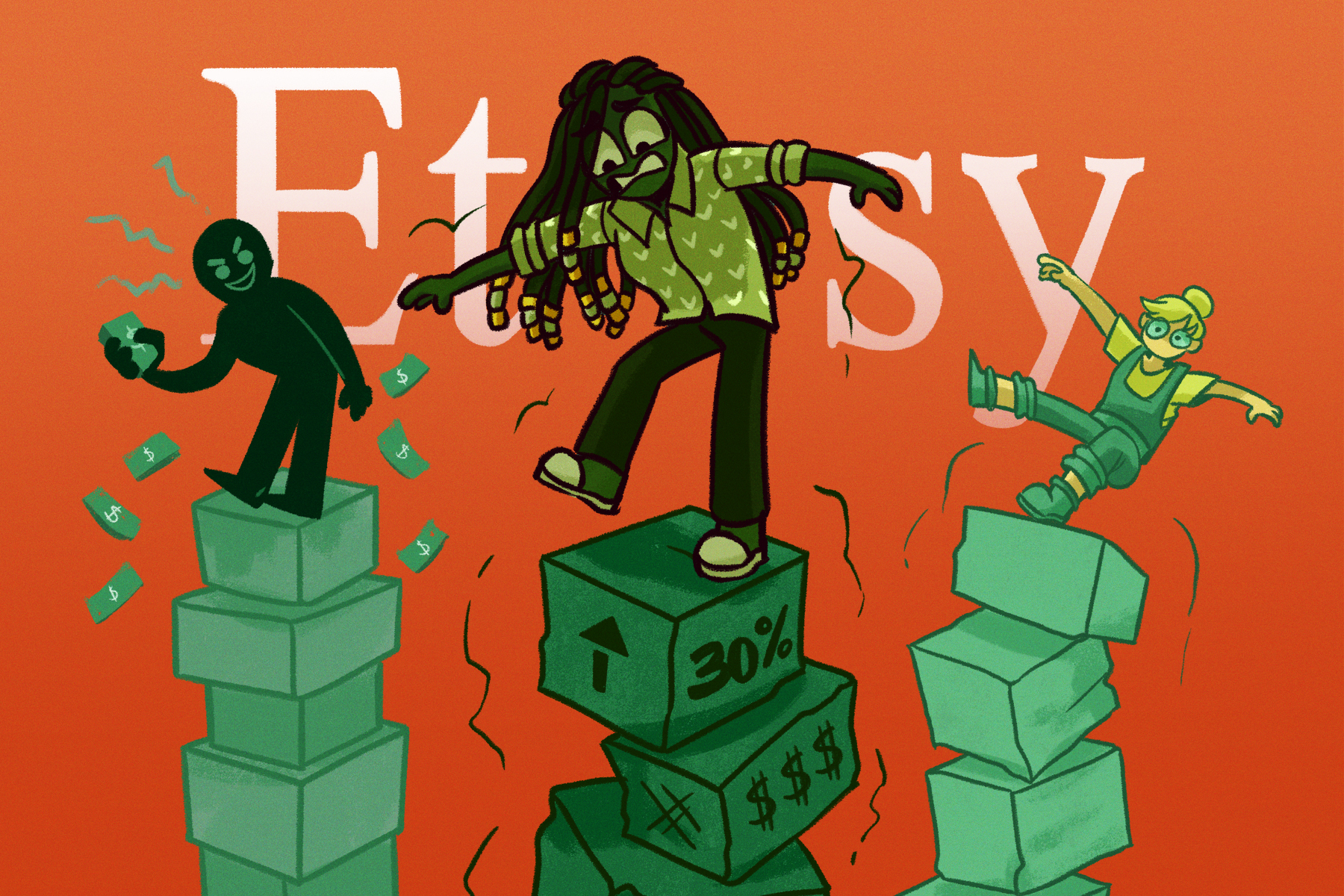In mid-February, Etsy CEO Josh Silverman announced the company’s plan to raise transaction fees from 5% to 6.5%, a change that went into effect on April 11. Silverman justified this 30% increase by noting Etsy’s plan to “make significant investments in marketing, seller tools, and creating a world-class customer experience,” referencing an uptick in the site’s customer base between the end of 2019 through the end of 2021. This decision made vendors furious as the site previously raised fees in 2018 from 3.5% to 5%, a nearly 43% increase based on the exact same justification. Not to mention, Silverman’s statement implies that Etsy, not the vendors or customer base, facilitated the 23% increase in sales.
Subsequently, thousands of Etsy vendors went on a strike by putting their shops on vacation mode from April 11 to April 18, while hundreds more plan to migrate off the site. Etsy advertises itself as a “shop for handmade, vintage, custom and unique gifts”; it’s safe to assume that a majority of the site’s shops are going to be either small businesses or independent vendors. On top of that, most sellers are working with a small budget compared to prominent retailers, and this fee, along with others, will only diminish the already little profit a seller earns.
Soon after Silverman’s announcement, Etsy seller Kristi Cassidy took to the internet and created a petition that listed the numerous grievances of the Etsy seller and customer communities. The petition, named “Cancel the fee increase. Work with sellers, not against us!,” also listed several other demands, including calls to “crack down on resellers” — or fake vendors who purchase bulk goods from websites like AliExpress to pass off as their own designs — and to include the option for sellers to opt out of the site’s “Offsite Ads” policy, regardless of whether or not they reached the $10,000 within 365 days threshold required.
Etsy is notorious for saddling vendors with a lot of fees, and for sellers, all of those charges add up. Along with the newly implemented 6.5% transaction fee, sellers also are required to pay $0.20 per product listing every four months and an additional 3% fee automatically taken by Etsy. A third fee, the 12-15% “Offsite Ads” fee, is the most controversial among Etsy sellers as the fee is charged completely at random and is wildly unfair for small vendors who are unable to reach that $10,000 revenue threshold on a regular basis. For those that cannot opt out, the “Offsite Ads” fee is charged whenever a customer clicks on a listing advertised on another site and then buys anything from the seller within 30 days; the seller will be charged a 15% advertising fee, or 12% if they met the $10,000 threshold and chose not to opt out.
Despite its financial growth, Etsy’s popularity is on the decline in the eyes of consumers. As a site that advertises itself as one that “empowers sellers,” Etsy only continues to stray further away from its original mission, proving time and again it’s done nothing but hurt vendors. The same day Etsy implemented the new transaction fee, founder Rob Kalin tweeted “I support @EtsyStrike. This is getting ridiculous. Time to build a better marketplace for handmade goods” in solidarity with striking sellers. According to the Etsy Strike website, the company is refraining from making any solid statements except for a vague acknowledgment of how sellers “have consistently told us they want us to expand our efforts around marketing, customer support and removing listings that don’t meet our policies.” This is a problem promised to be fixed with the money made from the fee increase despite the fact that between 2018 and 2021, Etsy collected $32 billion in gross marketplace sales.
How To Support Etsy Vendors
While the Etsy strike received immense support from sellers and consumers, it is also important to consider those who could not afford to strike for a week straight. For many, Etsy is a seller’s only source of stable income and it is no coincidence that the site’s heaviest traffic occurred at a time when working in-person, or even at all, was not a viable option; as a result, many turned to the site for supplementary income by selling their art or handmade goods from home. As a result, not all vendors participated in the strike, either because of the need for income or the belief that the strike wouldn’t change anything. However, there are still ways to support vendors without using Etsy.
1. Shop Directly from a Vendor’s Independent Website
Etsy’s status as a “marketplace” allows the site to double as something like a search engine for goods ranging from handmade furniture to pieces other vendors use to build their own products. A vendor’s Etsy page is basically a business card, and like a business card, they are bound to include social media handles and possibly the name of their own website outside of Etsy, all of which can be used to buy their products directly.
2. Report Fake Vendors
Over the past several years, thousands of fake vendors or reseller accounts started cropping up on Etsy; despite the website’s threats to deactivate any shops that are caught selling fake items, the problem continues to grow. The upside to fake vendors is that they are fairly easy to spot — the most common indicators of a fake shop or reseller being an overly descriptive or repetitive listing title, a design that is obviously photoshopped onto a generic model photo or a product easily found on wholesale websites. Reporting fake shops as a customer sees them can help crack down on resellers.
3. Support Sellers Who Still Use Etsy
Despite Etsy’s numerous fees, the site is still one of the most accessible and, even if only a little, beneficial sites an independent vendor can use. Again, a lot of vendors run on a tight budget, one made smaller by Etsy’s new rules, so doing something as simple as offering to tip a vendor post-purchase through Cash App, Venmo or PayPal can be helpful, especially since there’s no tipping option on Etsy. Also using any membership sites that a vendor is signed up for like Ko-fi or Patreon is also acceptable as some sellers include links to their accounts on their Etsy bios.
Etsy prides itself on being a company that strives to “Keep Commerce Human” with a mission to “keep human connection at the heart of commerce.” But what is humane about squeezing every bit of money out of sellers, especially after Etsy rewarded its CEO $40 million the day fees increased — a $40 million that would cover a portion of the money needed to “keep Etsy a beloved, trusted and thriving marketplace.”

















